New tools for counseling on prenatal genetic testing
As new screening options become available, ob/gyns must be able to counsel their pregnant patients appropriately.
©vege-stock.adobe.com

Table 1
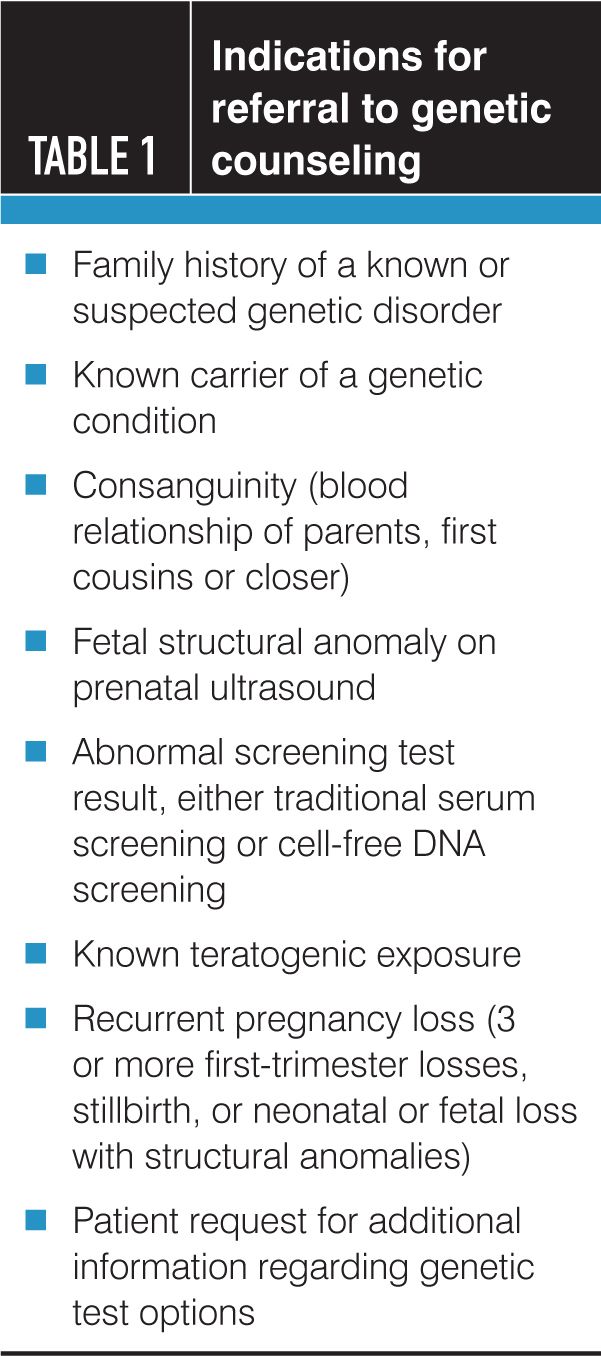
Table 2
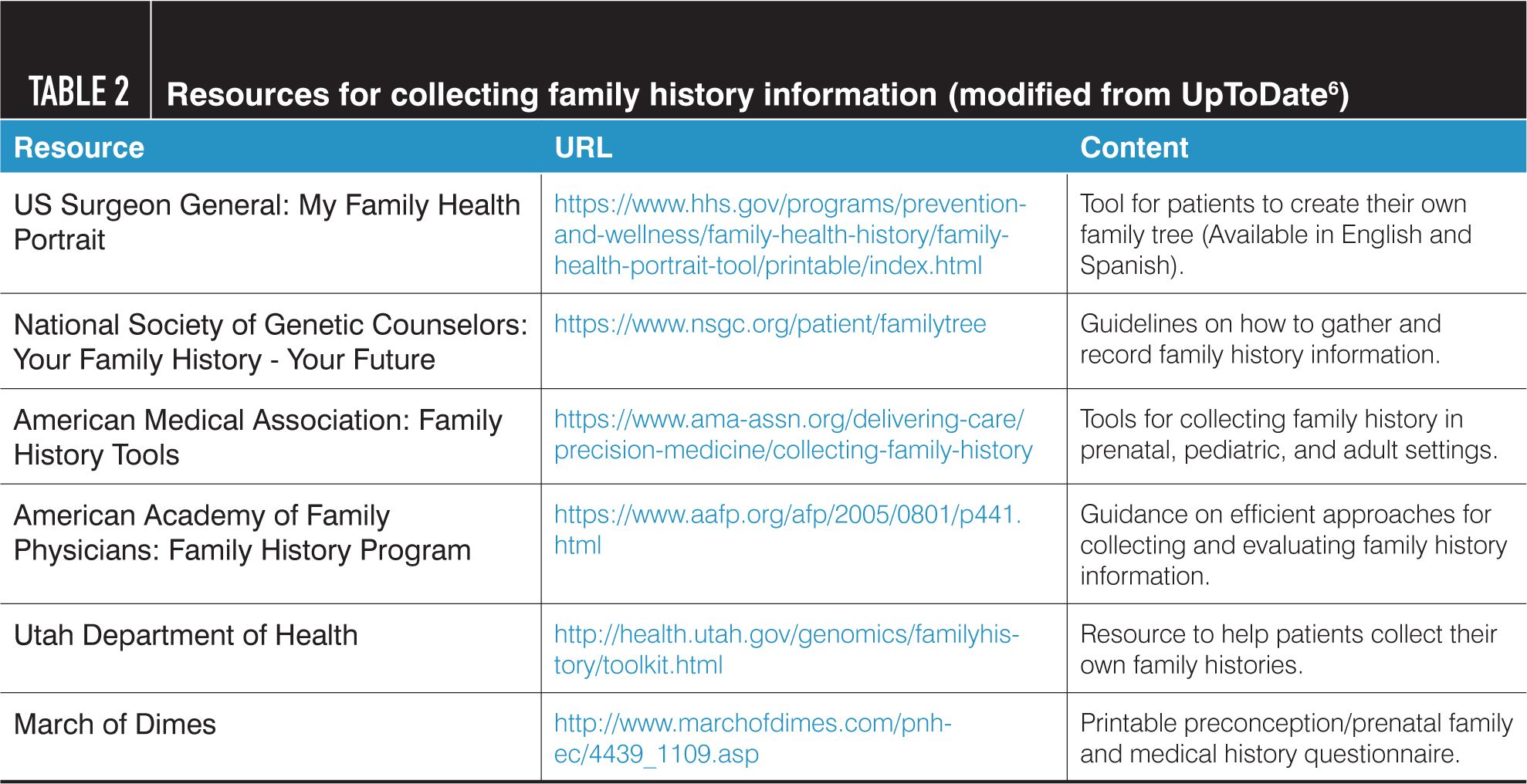
Table 3
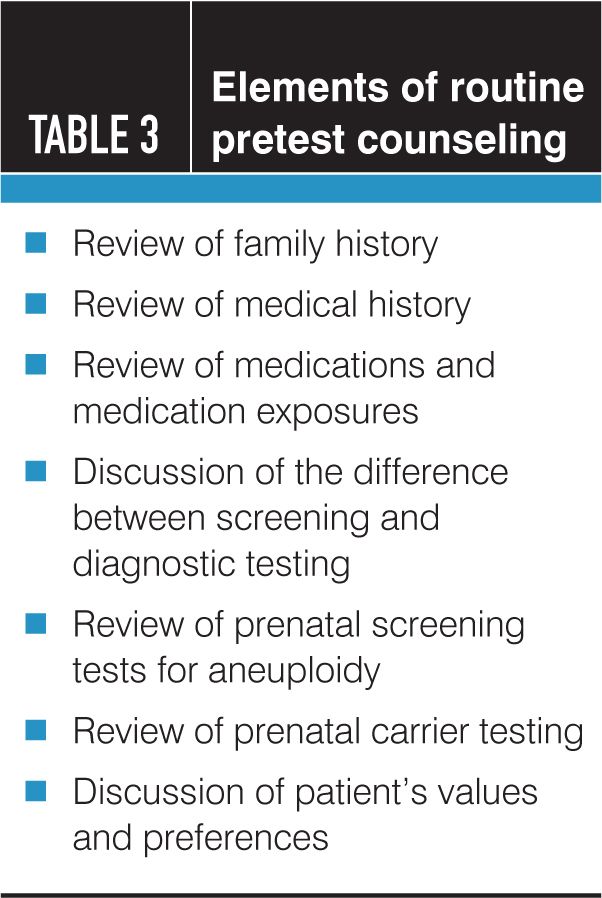
Table 4
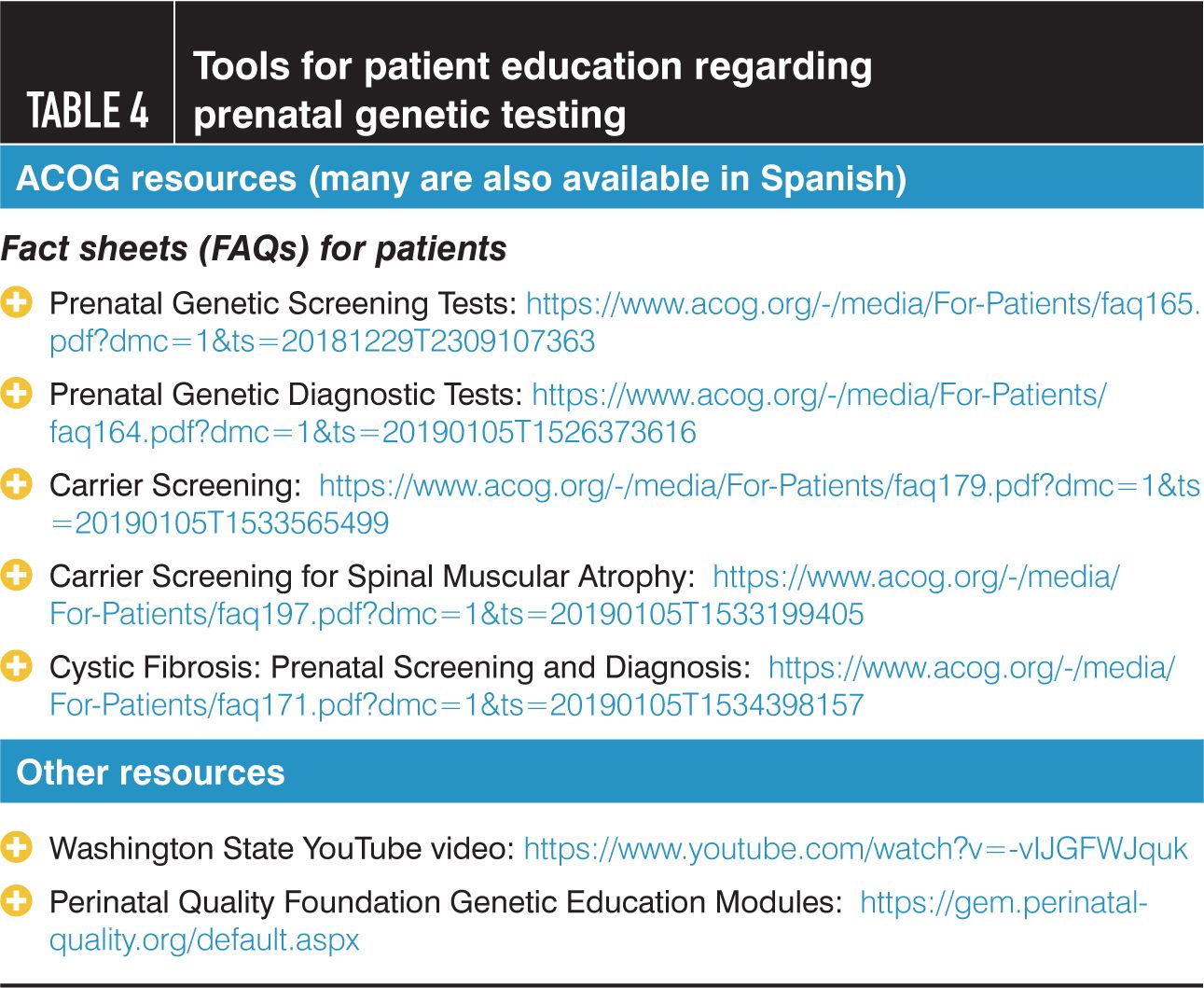
Table 5
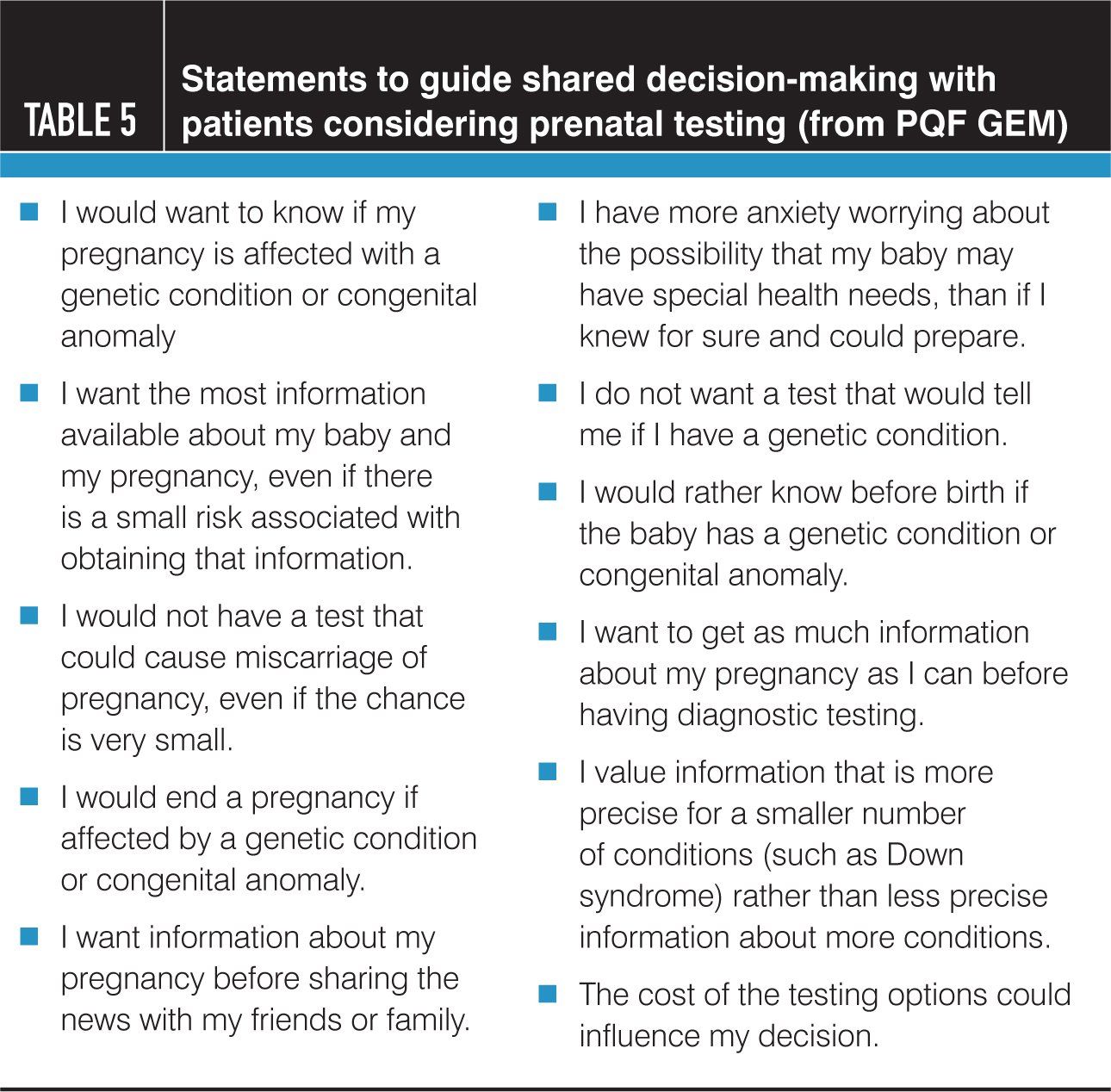
Obstetricians and their patients are faced with an increasingly complex array of prenatal screening and diagnostic testing options. With the benefit of more options comes the challenge of providing patients with the information they need to make an informed choice about testing that is consistent with their clinical situation and personal values. In a busy clinical setting, it’s often unrealistic to review the recommended content of pretest counseling as described by professional societies. In some cases, it’s prudent to refer a patient to a genetic counselor for discussion of testing options (Table 1); the National Society of Genetic Counselors and the American College of Medical Genetics and Genomics both provide information that can be helpful in locating genetic counseling services.1,2 However, it’s neither practical nor realistic to send every prenatal patient for formal genetic counseling. Therefore, obstetricians need to have a strategy to provide basic pretest education and counseling to their pregnant patients. This article discusses the important elements of pretest counseling that should be provided to every prenatal patient, and some suggestions on how to do such counseling in a manner that is adequate and yet realistic.
Current recommendations for testing
The American College of Obstetricians and Gynecologists (ACOG) makes several recommendations regarding patient counseling about testing for aneuploidy, as well as for carrier screening. According to ACOG, “[a]neuploidy screening or diagnostic testing should be discussed and offered to all women early in pregnancy…”.3 ACOG also recommends that all women be offered carrier screening that includes, at a minimum, cystic fibrosis (CF) and spinal muscular atrophy (SMA); additional tests may also be recommended depending on the patient’s race and ethnicity.4 Genetic testing should be an informed patient choice, with an underlying foundation of shared decision making that fits the patient’s clinical circumstances, values, interests, and goals. Clearly, complying with these recommendations is challenging in the context of an initial prenatal visit that must also address other important aspects of prenatal care.
Elements of routine pretest counseling
Review of family history
While most genetic disorders occur in patients with no relevant family history or risk factors, patients who have a family history of concern often benefit from genetic counseling. ACOG recommends that all women have a family history evaluation for inherited risk.4,5 Genetic counselors typically assess family history by creating a three-generation pedigree, but there are also tools available to collect family history information (Tables 2,3).6 In a busy obstetrical practice, use of this type of family history questionnaire or checklist is usually the most practical. Asking patients to complete the questionnaire prior to the clinic visit can ensure that patients have time to contact family members as needed to collect more accurate information. Any positive responses should be followed up to obtain more detail, including the relationship of the affected family member(s) to the patient, exact diagnosis, age at onset, and severity of disease. Concern is generally greatest when there is an affected first-degree relative (parent or sibling) and less commonly when a more distant relative (aunt, uncle, grandparent, or cousin) has a genetic disorder. An exception is with X-linked disorders, in which case a genetic variant can be passed through unaffected female relatives. Concerns in first-degree relatives, or for X-linked disorders related through female relatives, should prompt consideration of referral for formal genetic counseling.1
Importantly, simply ordering expanded carrier screening is not adequate to assess risk for a familial genetic disorder. While expanded carrier screening may include testing for a gene or genes that cause a particular disorder, such panels may not include all variants in a given gene. Therefore, the detection rate of expanded carrier panels is usually lower than targeted testing. Ideally, the specific variant in the family should be identified in order to provide accurate genetic counseling and prenatal testing.What is the purpose of prenatal genetic testing? Does every patient want such information?
The purpose of prenatal genetic testing is to determine if a fetus has a genetic disorder. Obtaining such information can serve several purposes; for most women, results are normal and they receive reassurance. For some fetal disorders, prenatal diagnosis allows the family to prepare for the birth of a child with special needs. Early detection of conditions such as cystic fibrosis may ensure early institution of appropriate care after birth. For a few conditions, prenatal detection may lead to a change in pregnancy management or delivery location. In many cases, however, the family is faced with a decision regarding pregnancy termination when no perinatal interventions are available to improve outcomes.
Related - Should Genomic Testing Be Routine After Stillbirth?
As patients consider prenatal testing, it is important that they understand the reasons that women choose to undergo, or in some cases to decline, prenatal genetic testing. This part of the conversation can be done with a simple explanation and a question: “There are a number of genetic tests that are available to test for different types of birth defects or genetic disorders. There is a range of conditions that we can find, and some are treatable, while for others, no treatment is available. It is your choice whether to have such testing, or if you would like more information about different tests and options. Are you interested in learning more about testing for birth defects?” Some women may decline testing altogether, and that is an acceptable decision that should be supported and documented in the medical record. For women who are uncertain, or want to hear more about options, the next step is a discussion of the difference between screening and diagnostic testing.
What is the difference between screening and diagnostic testing?
One of the most important basic concepts of genetic testing is the difference between screening tests, which help a patient refine her risks, and diagnostic tests, which tell a patient for certain if her fetus is affected with a genetic disorder. As a general rule, screening tests are noninvasive and include ultrasound, such as nuchal translucency; maternal serum tests (such as first- or second-trimester screening); and cell-free DNA (cfDNA) screening. Diagnostic testing, in contrast, generally requires an invasive procedure such as amniocentesis or chorionic villus sampling for fetal karyotyping or chromosomal microarray. Diagnostic tests are far more comprehensive and accurate, while screening tests carry no miscarriage risk.
Many patients who undergo cfDNA screening are confused by the nomenclature “noninvasive prenatal testing,” which implies that it is a noninvasive alternative to diagnostic testing. In fact, it is more appropriately presented as an alternative to other screening options (“cell-free DNA screening”). In addition to presenting a simple explanation of the difference between these types of tests, there are patient education tools available through ACOG. A short video available through the Washington State Department of Public Health also explains the difference between prenatal screening and diagnostic tests. The Perinatal Quality Foundation’s Genetic Education Modules (GEM) also discuss the different prenatal screening and diagnostic tests that are available, with a “test at a glance” page that clearly illustrates the differences (Table 4).
Regardless of whether a provider refers patients to one of these tools, or explains the tests in person, ensuring that pregnant women understand the difference between screening and diagnostic testing is one of the most important concepts in pre-test counseling (Table 5). Patients who undergo screening may incorrectly assume that they are diagnostic and that such tests indicate with certainty either that a fetus is “normal” with a guarantee that no anomalies are present or is affected with a congenital disorder because a screening test suggests an increased risk. Women should be counseled that all positive screening tests require diagnostic confirmation before irreversible actions (such as pregnancy termination) are undertaken.
Review of prenatal screening and diagnostic tests for aneuploidy
Once assured that a patient understands the difference between screening and diagnostic testing, a provider can then discuss options with a more targeted approach. Different patients, providers, and practices may have access to different test options. ACOG recommends that “[a]ll women should be offered the option of aneuploidy screening or diagnostic testing for fetal genetic disorders, regardless of maternal age,” but does not require that specific tests need to be offered. In the past, women under 35 years old were commonly offered aneuploidy screening, while women 35 and older were often referred to genetic counseling for a comprehensive review of genetic testing options or were offered the options of aneuploidy screening versus diagnostic testing. In contrast, recent recommendations note that while “maternal age may be helpful in adjusting an individual woman’s risk of having a fetus with aneuploidy, it should not be used as the sole determinant of whether aneuploidy screening or diagnostic testing is offered.” Most important is that all women are offered testing, and that the offer of testing be consistent in the practice. Many tools are available that compare and contrast testing options for patients, including the PQF GEM module, the ACOG FAQs or the Washington state video (Table 4). Practices may also create their own brochures, videos, or other tools to describe available options.Review of prenatal carrier testing
Advances in sequencing techniques have made carrier screening for single-gene disorders more comprehensive and less costly, as well as much more complex. As noted above, ACOG recommends that all women be offered some type of carrier screening that includes, at a minimum, cystic fibrosis (CF) and spinal muscular atrophy (SMA); additional tests may also be recommended depending on the patient’s race and ethnicity.4 Each provider should determine an approach to screening that best fits their population: ethnicity-based, pan ethnic, or expanded carrier screening. In traditional ethnicity-based screening, the conditions included are targeted to those associated with a specific ethnic group, such as Ashkenazi Jewish disease screening or hemoglobinopathy screening for patients of African, Mediterranean, or Middle Eastern ancestry. Due to growing admixture of ethnicities, some are moving towards pan ethnic screening, in which a panel of recommended conditions is offered to all patients regardless of their ancestry. Expanded carrier screening is the most comprehensive carrier screening option, with screening panels that can include well over 100 recessively inherited conditions.
Regardless of the approach an obstetrician chooses for his or her practice, it is critical that patients be informed of the benefits and limitations of testing, including a reminder that results cannot completely rule out carrier status, though a negative result significantly reduces the chance that an individual is a carrier. One must also bear in mind that, unlike aneuploidy screening in which only the pregnant woman needs to undergo testing, carrier screening may require testing of the reproductive partner. It is important that a woman knows before undergoing screening that if she is found to be a carrier of an autosomal-recessive condition, testing of the biological father also will be recommended. It should also be noted that the larger the screening panel, the higher the screen-positive rate (up to 60% with very large panels) and the higher the likelihood of needing to test the partner. If the biological father is unknown, not available or unwilling to be tested, that might affect a woman’s decision to pursue carrier screening. As with aneuploidy screening, a woman must also know that if carrier status is confirmed in both members of the couple, diagnostic testing of the fetus would require invasive testing (CVS or amniocentesis). Once again, decisions should take into account a woman’s values, needs and desires.
Discussion of patient’s values and preferences
Final decisions about prenatal genetic testing must consider individual patients’ values and preferences. Patients should not have blood drawn for genetic tests as part of their routine prenatal labs without a conversation and consent. For many women, initial discussions about the purpose of prenatal testing may lead to a mutual decision that the best option is to forgo genetic testing altogether. Others value the certainty and comprehensive nature of diagnostic testing, while many women want to refine their risk with screening tests as a first step.
For some women, it may be helpful to complete a decision aid, such as that available through the PQF GEM website (Tables 4 and 5). Answering questions about the relative value of the information obtained can help women better consider the best option for them.
Conclusion
The prenatal genetic testing landscape has expanded significantly. While that is often daunting to patients and providers, tools are available to help navigate this process. Reviewing the available tools, and deciding which are most appropriate for each practice, can be helpful in streamlining this component of prenatal care, while ensuring that all patients have access to appropriate information.
Disclosures:
The authors report no potential conflicts of interest with regard to this article.
References:
- National Society of Genetic Counselors home page. Available at https://www.nsgc.org/ Accessed January 8, 2019.
- American College of Medical Genetics and Genomics home page. Available at https://www.acmg.net Accessed January 8, 2019.
- American College of Obstetricians and Gynecologists Committee on Practice Bulletins-Obstetrics, Committee on Genetics, and the Society for Maternal-Fetal Medicine. Practice Bulletin No. 163: Screening for Fetal Aneuploidy. Obstet Gynecol. 2016 May;127(5):e123-37.
- American College of Obstetricians and Gynecologists Committee on Genetics. Committee Opinion No. 690: Carrier Screening in the Age of Genomic Medicine. Obstet Gynecol. 2017 Mar;129(3):e35-e40.
- Committee Opinion No. 478: Family history as a risk assessment tool. American College of Obstetricians and Gynecologists Committee on Genetics. Obstet Gynecol. 2011 Mar;117(3):747-50
- Raby BA, Kohlman W, Venne V. (2018) Genetic counseling: Family history interpretation and risk assessment. Tirnauer JS, ed. UpToDate. Waltham, MA: UpToDate Inc. https://www.uptodate.com.
Gene-editing technology: potential to usher in a new age in medicine
September 24th 2021CRISPR gene-editing technology holds the potential to usher in a new age in medicine, according to a featured speaker at the North American Menopause Society Annual Meeting, being held this week in Washington, D.C.
Read More










